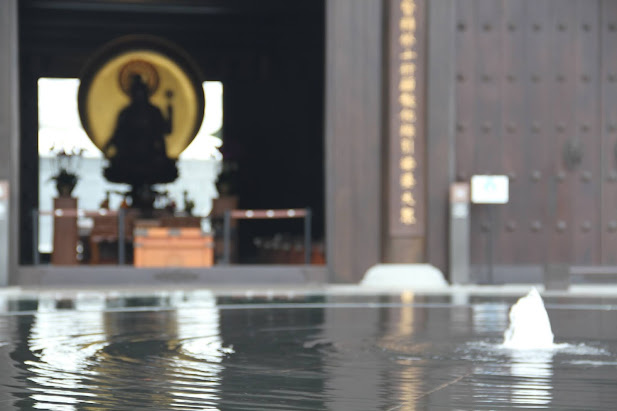In front of the Universal Gate Hall 普門 is the 8-meter Brilliance Pond 洛伽池, said to be named after the mythical Mount Potalaka, the abode of Avalokiteśvara, according to the Gaṇḍavyūhasūtra 入法界品 of the Avataṃsakasūtra 華嚴經, an important text of the Mahāyāna tradition.
Where is Mount Potalaka? It was said to be a mythical mountain located in the south of India. For those who have read the popular Chinese translation of Gaṇḍavyūhasūtra, the eighty-fascicled Huayan 八十華嚴 translated by Śikṣānanda 實叉難陀 in the late seventh century CE during the reign of Empress Wu Zetian, one may recall the adventure of the tireless Sudhana in search of spiritual teaching, and Avalokiteśvara was among one of his fifty-three spiritual guides:
善男子!於此南方有山,名補怛洛迦,彼有菩薩,名觀自在。(T10n0279_p0366c)
The name Potalaka is found the Sanskrit recension of the Gaṇḍavyūhasūtra (Gv 159):
atha khalu sudhanaḥ śreṣṭhidārako veṣṭhilasya gṛhapater anuśāsanīm anuvicintayan...anupūrveṇa yena potalakaḥ parvatas tenopasaṃkramya potalakaṃ parvatam abhiruhya avalokiteśvaraṃ bodhisattvaṃ parimārgan parigaveṣamāṇo 'drākṣīd avalokiteśvaraṃ bodhisattvaṃ paścimadikparvatotsaṅge..."
"Then, the merchant’s son Sudhana pondering upon the instruction of the householder Veṣṭhila… arrived then first at Mount Potalaka. Having climbed Mount Potalaka, he searched for the bodhisattva Avalokiteśvara. Looking around, he (finally) saw the bodhisattva Avalokiteśvara on a plateau on the west of the mountain..."
A number of scholars have examined the scanty descriptions, including those of Xuanzang and others, and attempted to identify the earthly locale that inspired the mythical Potalaka. Given the great popularity of the worship of Avalokiteśvara in Asia, Sudhana's spiritual adventure and the mythical Potalaka nonetheless became the inspiration of a number of real places.
In China, the most famous place associated with Potalaka is Mount Putuo 普陀山 in Zhejiang 浙江, considered one of the four sacred mountains in Chinese Buddhism. I first visited the mountain when I attended the First World Buddhist Forum 世界佛教論壇 in 2006. It is a truly beautiful place and a meaningful place to visit as it has been a site of pilgrimage and worship of Guanyin for over a thousand years since the Tang Dynasty. In Tibet, the Potala Palace པོ་ཏ་ལ། in Lhasa was also named after Mount Potalaka. Many other places in Asia also have such connection if we pay closer attention. For example, the historical 53 Stations of the Tōkaidō 東海道五十三次 between Tokyo and Kyoto were conceived as a metaphor of Sudhana's journey.
But why was the fountain called Brilliance Pond? I was slightly annoyed that the Sanskrit name was not used instead. Yesterday I posed the question to Walter and Walter told me that I was the one who came up with the name! I have no recollection and had to dig up the archive to unravel the story.
Back in May 2013 when TSM was still under construction, Walter and Ven. Thong Hong asked me to help them to review all the English names used in the monastery, and especially those connected with Sanskrit since I was teaching Sanskrit and Buddhist philology at the University of Hong Kong at that time. The fountain was first given the Chinese name 洛伽池 in connection to the abode of Avalokiteśvara and the English name was provisionally given as Potalaka. In a document dated 9 May 2013 [arch/2013/1], I proposed the name to be changed to Pond of Brilliance on the following ground:
"The reference to the pond in the Gaṇḍavyūha Sūtra is actually rather obscure in the history of Buddhism. General English translation is preferable."
From the Pond of Brilliance, now we have Brilliance Pond.





No comments:
Post a Comment